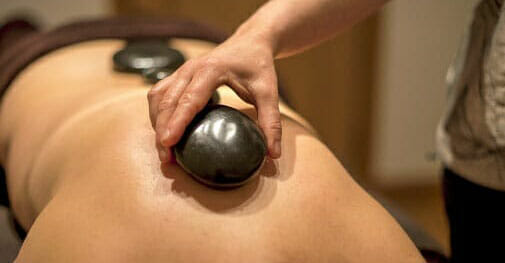When you think of hot stone massage, you might think of the stock photos of young women with flowers in their hair and stones placed along their spine. However, these images don’t quite convey the reality of the blissful experience of a good hot stones massage!
The stones used are usually basalt stones. These are smooth, volcanic stones that retain heat well. They are heated in hot water in a stone heater – rather like a crock pot – before use. The stones are used as an extension of the therapist’s hands in massage strokes over your body. They may be used in long flowing strokes as well as being used more specifically to work into areas of tension or trigger points. The heat from the stones helps to soften muscles and can be combined really well with deep tissue techniques, the heat-softened muscles allowing more depth and release of tension.
There has not been a great deal of research done into the benefits of hot stone massage itself. One study has shown that it can enhance quality of sleep in haemodialysis patients (2)! However, many studies have shown that heat can be beneficial in various ways. For example, in cases of low back pain (1), in helping with pain and increasing range of motion in frozen shoulder (4) and with pain and stiffness in arthritic joints (3). It is why we reach for the hot water bottle when we have a sore back or climb into a hot bath. Heat increases blood circulation, helps with pain and is comforting and relaxing.
The experience of a hot stone massage is a luxurious one of deep relaxation and lingering warmth. It is perfect for the cold, dark winter days. Ideally leave some time after your session to enjoy the aftereffects. Be prepared to float home.
By Charlotte Softly.
References
1. French, Simon D., MPH, BAppSc(Chiro); Cameron, Melainie, PhD, BAppSc(Osteo) et al (2008) A Cochrane Review of Superficial Heat or Cold for Low Back Pain, Spine, 31 (9): 998-1006
2. Ghavami Haleh, Shamsi Aldine et al (2019) Impact of hot stone massage therapy on sleep quality in patients on maintenance hemodialysis: A randomized controlled trial, J Res Med Sci., 24(1): 71
3. Hayes, Karen W. (1993) Heat and Cold in the Management of Rheumatoid Arthritis, Arth & Rheum. 6(3): 155-166
4. Leung, May S. F. & Cheung, Gladys L. Y. (2008) Effects of Deep and Superficial Heating in the Management of Frozen Shoulder, J Rehab Med., 40(2): 145-150

